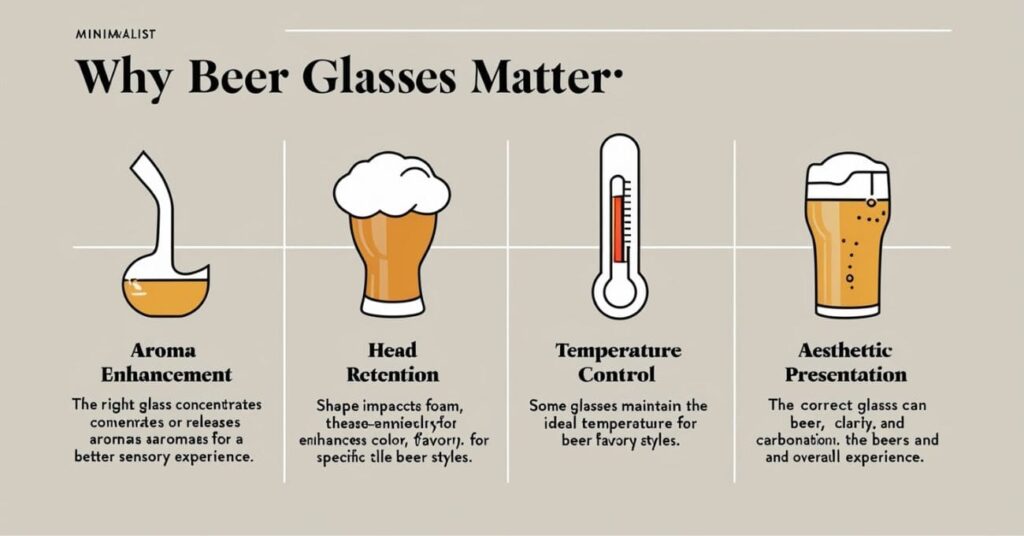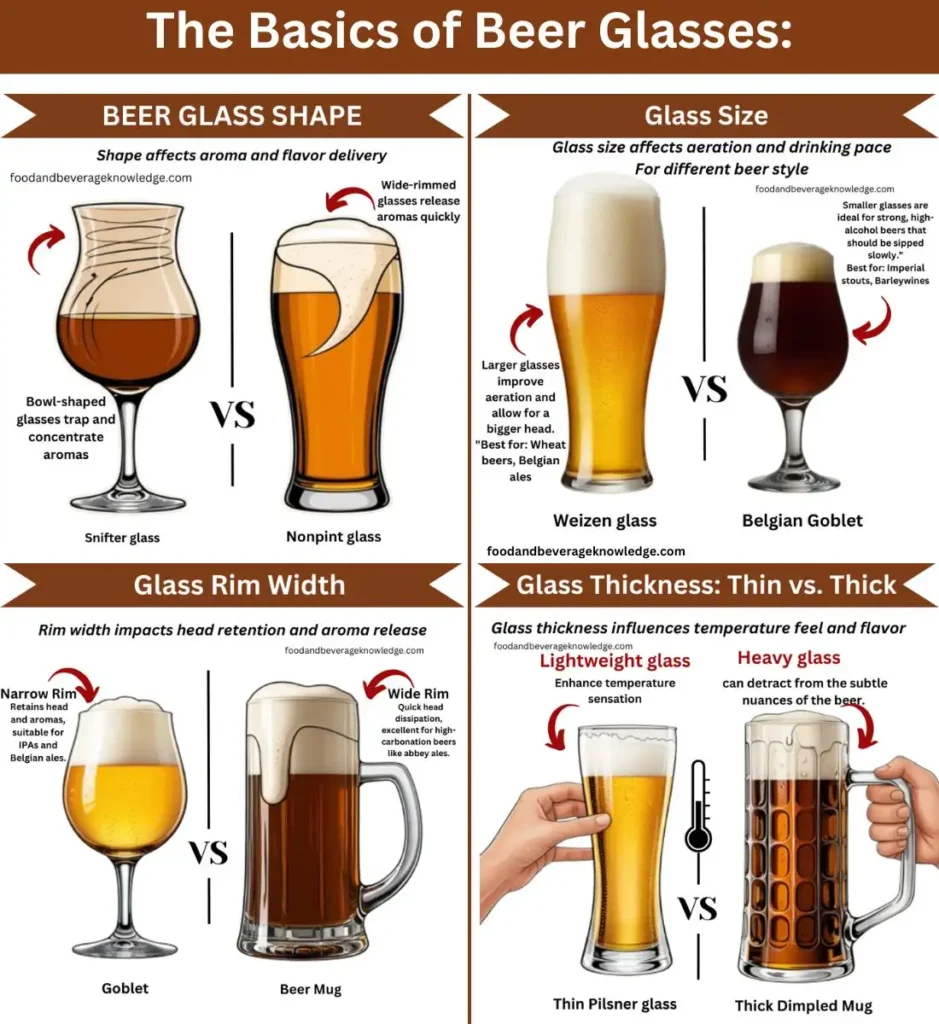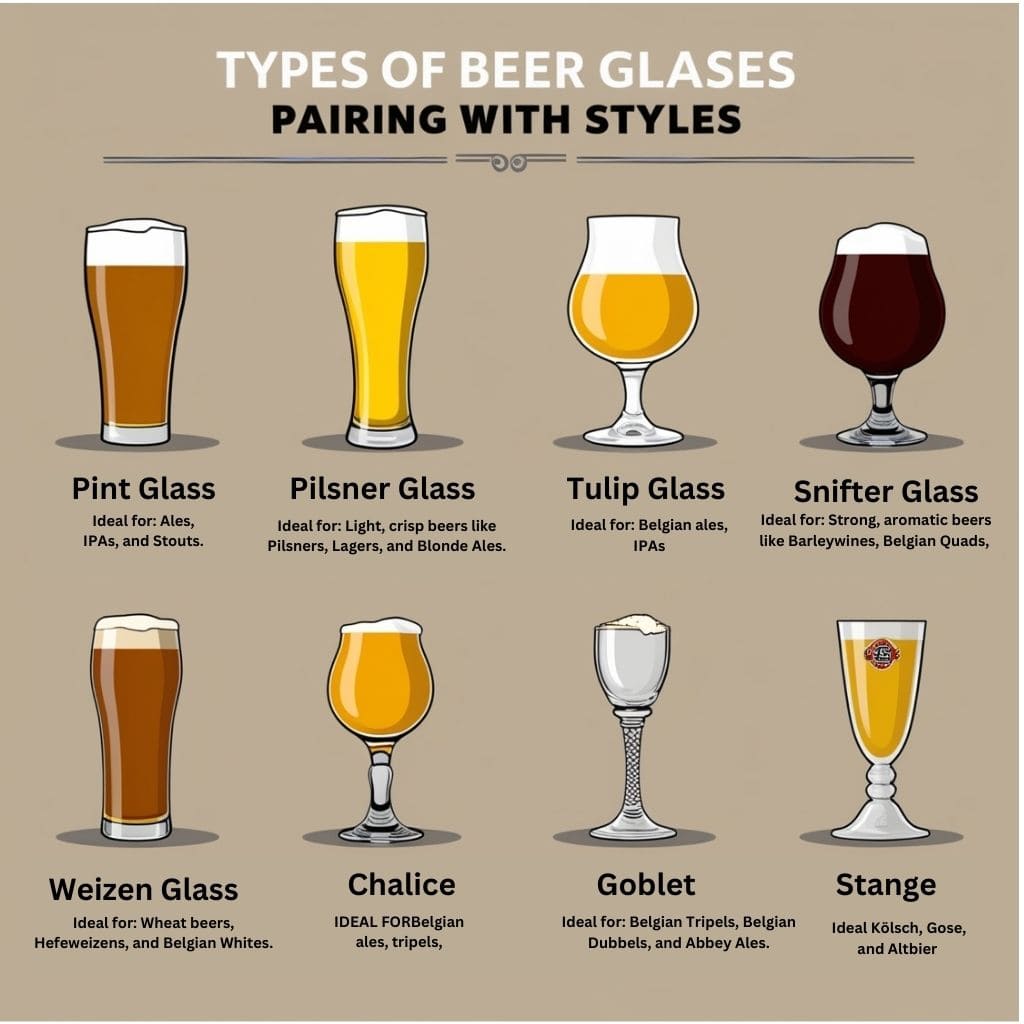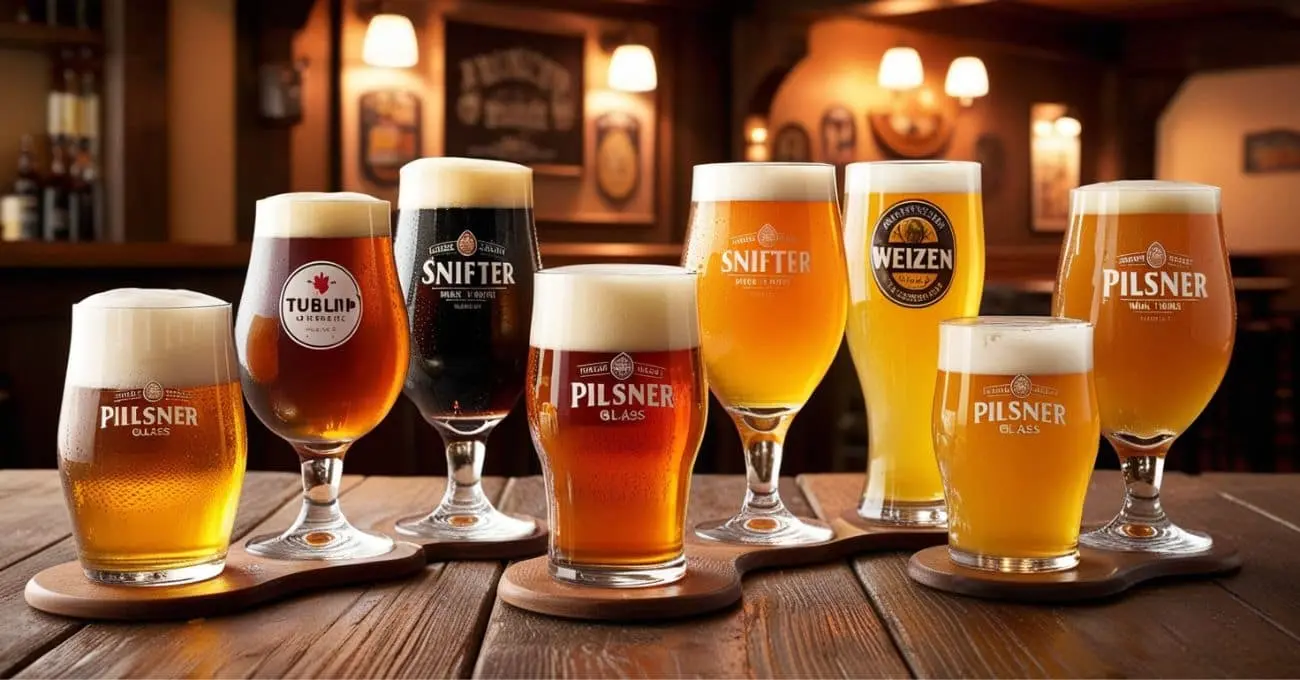When it comes to beer, the right glass makes all the difference. Whether you’re a casual drinker or a devoted beer enthusiast, selecting the proper beer glass can elevate your beer-drinking experience by enhancing the aroma, flavour, and even presentation.
This guide will walk you through the essential types of beer glasses, why they matter, and how to choose the right one for your beer.
Let’s dive into the world of beer glassware and explore how different shapes and styles can transform your next pint!
Why Beer Glasses Matter

Most people are familiar with the idea that the right wine glass enhances the flavor of wine, but the same is true for beer. While it’s tempting to grab the nearest pint glass or bottle, using the correct beer glass can completely change how you perceive the taste, aroma, and overall experience.
Here’s why beer glasses matter:
- Aroma Enhancement: The shape of the glass can concentrate or disperse the beer’s aroma. For example, a tulip glass allows the scent to collect in the bowl, intensifying the aromas.
- Head Retention: Different glasses promote different levels of head retention, which affects both the flavor and aroma. Glasses with narrow rims, like a snifter, keep the foam in place longer, while wide-rimmed glasses allow for a more rapid release of the head.
- Temperature Control: Some beer glasses, like a snifter, are designed for holding the beer in your hand, which warms the liquid slightly – ideal for beers that benefit from being consumed at higher temperatures.
- Aesthetic Presentation: Beer glasses can visually enhance the experience, showcasing the beer’s color and clarity. Wheat beer in a Weizen glass, for example, shows off its hazy, golden color beautifully.
In short, the right glass brings out the best qualities in your beer, ensuring that every sip is as enjoyable as possible.
The Basics of Beer Glasses
Before we explore the different types of beer glasses, it’s important to understand the basic characteristics that make each glass unique. This will help you appreciate why certain beer styles work better with specific glasses.
Let’s us look at the infographic of the basics of beer glasses to understand the key factor

Here are some key factors that define a beer glass:
- Shape: The shape of the glass plays a critical role in how the beer’s aroma and flavour are delivered to your senses. Bowl-shaped glasses (like a snifter) concentrate aromas, while wide-rimmed glasses release them quickly.
- Rim Width: A glass’s rim affects how quickly the beer’s head dissipates and how much aroma is released with each sip.
- Size: Larger glasses accommodate beers with more heads or those that benefit from aeration, while smaller glasses are ideal for high-ABV beers that are meant to be sipped slowly.
- Material: Thin glass is preferable because it allows you to feel the beer’s temperature and ensures a more natural experience when drinking. Heavy glass can detract from the subtle nuances of the beer.
With these basics in mind, let’s move on to the different types of beer glasses and which beers they complement best.
Also Read: The Ultimate Guide to Serving Beer: Tips, Techniques, and Best Practices
Types of Beer Glasses and Their Best Uses
Choosing the right glass for your beer can feel overwhelming, but it doesn’t have to be. Here’s a breakdown of the most popular types of beer glasses and the styles of beer they work best with.

1. Pilsner Glass
Ideal for: Light, crisp beers like Pilsners, Lagers, and Blonde Ales.
Why it works: Pilsner glasses are tall, slender, and slightly tapered. This design showcases the beer’s pale color, effervescence, and clarity. The narrow shape also helps retain carbonation, making each sip feel refreshing.
Key Characteristics:
- Height: Tall and thin.
- Capacity: 12–20 oz.
- Ideal Beer Styles: Pilsners, Light Lagers, Blonde Ales.
2. Pint Glass
Ideal for: Ales, IPAs, and Stouts.
Why it works: Pint glasses are one of the most versatile and common beer glasses. Their wide rim encourages quick head dissipation, making them ideal for beers that don’t require long-lasting foam. They are easy to hold and pour, making them a staple in most bars and homes.
Key Characteristics:
- Shape: Wide mouth, straight sides.
- Capacity: 16 oz (US), 20 oz (UK).
- Ideal Beer Styles: Pale Ales, IPAs, Porters, Stouts.
3. Snifter Glass
Ideal for: Strong, aromatic beers like Barleywines, Belgian Quads, and Imperial Stouts.
Why it works: Snifters have a bowl-shaped design that traps and concentrates the beer’s aroma, allowing you to fully experience the complex scents of high-ABV beers. The smaller size also encourages slow sipping, making it perfect for strong beers.
Key Characteristics:
- Shape: Large bowl with a narrow opening.
- Capacity: 10–14 oz.
- Ideal Beer Styles: Barleywines, Belgian Quads, Imperial Stouts.
4. Tulip Glass
Ideal for: Belgian Ales, Saisons, and Sour Ales.
Why it works: The bulbous shape of a tulip glass helps capture and amplify the beer’s aroma, while the flared lip supports a thick head of foam. It’s perfect for beers with fruity or floral aromas and those that benefit from a generous head.
Key Characteristics:
- Shape: Round bowl with a flared rim.
- Capacity: 12–16 oz.
- Ideal Beer Styles: Belgian Ales, Saisons, Lambics, Sour Ales.
5. Weizen Glass
Ideal for: Wheat beers, Hefeweizens, and Belgian Whites.
Why it works: The tall, curvy shape of the Weizen glass is designed to accommodate the thick head of wheat beers while showcasing their cloudy, hazy appearance. The narrow waist helps trap the beer’s aromas, enhancing the banana and clove notes typical of wheat beers.
Key Characteristics:
- Shape: Tall, curvy, and narrow in the middle.
- Capacity: 20–25 oz.
- Ideal Beer Styles: Hefeweizens, Wheat Beers, Belgian Whites.
6. Mug or Stein
Ideal for: Dark lagers, Marzens, and Bocks.
Why it works: Mugs and steins are sturdy glasses with thick walls that help keep the beer cold. The handle allows for easy holding, even with a full pour. These glasses are traditionally used for heavier, maltier beers that don’t require much head retention.
Key Characteristics:
- Shape: Sturdy with a handle.
- Capacity: 16–34 oz.
- Ideal Beer Styles: Dark Lagers, Bocks, Marzens.
7. Goblet or Chalice
Ideal for: Belgian Tripels, Belgian Dubbels, and Abbey Ales.
Why it works: Goblets and chalices have wide mouths and thick stems, ideal for sipping complex, high-alcohol beers. The wide surface area releases the beer’s aroma, and the heavy stem helps maintain a cool temperature.
Key Characteristics:
- Shape: Wide bowl with a thick stem.
- Capacity: 12–16 oz.
- Ideal Beer Styles: Belgian Tripels, Abbey Ales, Belgian Dubbels.
For those eager to explore further, I’ve included additional resources, like the Wikipedia article on Beer Glassware, which provides a fascinating look into how glass design can impact your drink.
How to Choose the Right Beer Glass
With so many beer glass options, how do you know which one to choose? Here are some key factors to consider:
Let’s first look at the infographic to better understand how the different beer glasses could be chosen

- Beer Style: The most important factor is the type of beer you’re drinking. A delicate pilsner calls for a slim pilsner glass, while a strong stout shines in a snifter.
- Aesthetic Preference: If presentation matters to you, choose a glass that highlights the color and texture of the beer. A Weizen glass, for example, beautifully showcases the cloudy look of a wheat beer.
- Versatility: If you’re building a home bar, start with a few versatile glasses, like a pint glass and a tulip glass. These can accommodate a wide range of beers.
- Capacity: Consider how much beer you typically pour. If you prefer smaller servings, a snifter or goblet might be ideal. For larger pours, a mug or stein could be a better fit.
Remember, the right glass enhances the beer-drinking experience, so don’t be afraid to experiment and find what works best for you!
Care and Maintenance of Beer Glasses
Now that you have the perfect beer glasses, it’s important to take care of them properly. Beer glasses can easily develop residue from oils or soap, which can affect the head and flavour of the beer.
Here’s how to keep your beer glasses in top condition:
- Hand Washing vs. Dishwasher: While some beer glasses are dishwasher-safe, it’s generally best to hand wash them to avoid etching or damage. Use warm water and mild soap.
- No Residue: Make sure there is no soap residue left on the glass, as it can interfere with head retention.
- Drying: Air-dry your glasses or use a lint-free cloth to avoid leaving fibres on the glass surface.
- Storage: Store your glasses upright in a cabinet or on a shelf. Avoid stacking them, as this can lead to breakage or scratches.
Popular Beer Glass Brands and Where to Buy Them
If you’re ready to invest in high-quality beer glassware, here are some popular brands to consider:
–
Spiegelau: Known for its premium beer glasses, Spiegelau offers a variety of shapes designed to bring out the best in each beer style.
- Libbey: A more affordable option, Libbey offers a wide range of durable beer glasses perfect for everyday use.
- Rascal: This German brand is well-regarded for its stylish and functional glassware, particularly for craft beers.
You can find these brands online at retailers like Amazon, Crate & Barrel, or speciality beer shops. For those seeking unique or customized beer glasses, Etsy or local craft stores may offer personalized options.
Learn more about beer brands:
ALSO READ: Top 13 Most Popular Beer Brands in the World
Conclusion: Elevate Your Beer Experience with the Right Glass
Choosing the right beer glass isn’t just about aesthetics – it’s about enhancing the flavor, aroma, and enjoyment of your beer. Whether you’re sipping a crisp lager in a pilsner glass or savouring a rich stout in a snifter, the right glass will make every beer taste its best.
Now that you know the ins and outs of beer glasses, it’s time to start experimenting. Try different styles of glasses with your favourite beers and see how they affect the experience. You may be surprised by the difference a simple glass can make!
For those passionate about the art of beer, the Brewers Association provides expert resources on elevating the drinking experience through proper glassware selection (Brewers Association).
FAQ: Beer glasses
Why does the type of beer glass matter?
Different glass shapes and sizes enhance a beer’s aroma, taste, and appearance, improving the overall experience.
Which glass is best for a pilsner?
A tall, slender pilsner glass is ideal as it showcases clarity and maintains carbonation.
How do I choose the right beer glass for different styles?
Factors like beer style, aroma, and desired experience help in choosing the best glass.
What are common types of beer glasses?
Popular types include pint glasses, snifters, tulips, and pilsners, each catering to specific beer styles.
Subscribe and join our community of hospitality professionals & students — get insights, tips, and the latest updates delivered straight to your inbox!







